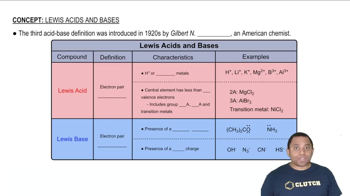Here are the essential concepts you must grasp in order to answer the question correctly.
Electron Deficiency
Electron deficiency refers to a situation where a molecule has fewer electrons than required to achieve a stable electron configuration, typically resembling that of a noble gas. This often occurs in molecules with incomplete octets, leading to a tendency to accept electrons from other species, making them reactive and often acting as Lewis acids.
Recommended video:
Lewis Acids and Bases
In the Lewis theory, acids are defined as electron pair acceptors, while bases are electron pair donors. Electron-deficient molecules often function as Lewis acids because they can accept electron pairs to complete their octet, facilitating various chemical reactions, including coordination and complex formation.
Recommended video:
Stability and Reactivity
The stability of a molecule is closely tied to its electron configuration. Electron-deficient molecules are generally less stable and more reactive due to their incomplete valence shells. This reactivity can lead to the formation of new bonds as these molecules seek to achieve a more stable electronic state through interactions with electron-rich species.
Recommended video:
Intepreting the Band of Stability

 Verified step by step guidance
Verified step by step guidance


